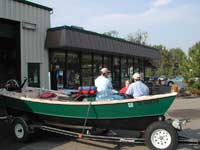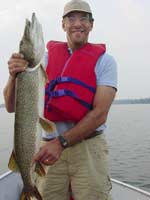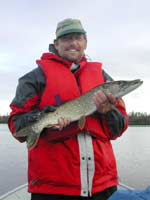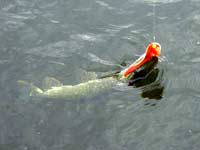Lessons from Basswood Lake
by David Nichols
Photos by Dwight Dare and David Nichols
On our first trip to Basswood Lake, the young women at the Prairie Portage had some very good advice for us, “keep your shallow water drive engaged and run slow where you’re not sure. There’re lots of underwater rocks out there and they can do a lot of damage.” I remembered her advice but our prop showed some small nicks and dings where it had kissed a few rocks with the shallow water drive engaged, running slow.
This year, our third trip to Basswood Lake and our eighth to the Boundary Waters Canoe Area (BWCA) in Minnesota, we thought we knew our way around but sometimes just when you think everything is running smoothly….well, it doesn’t. It’s just luck or Murphy’s Law.
I had done a great deal of planning for this trip. There were five people going this time instead of just my son, Harlan, and me. Harlan and I made gear and clothing lists for everybody based on our previous experiences in BWCA. I carefully planned the menu, being sure there would be plenty to eat for five hungry men. I allowed for two extra weather days of food and arranged with Spirit of the Wilderness, the outfitter we always use, to juggle our pick up date should we get weathered in and miss the pre-arranged pick up date at the take out site.
Spirit of the Wilderness before the trip
(click images to enlarge)
|
 |
|
Everything was going according to plan. The two guys that flew in arrived with minor travel delays but we were all there. Saturday morning we were at Spirit of the Wilderness on time and had the boats loaded with all the gear well before our 10:00AM depart time. Everyone got their fishing licenses and entry permits quickly (Spirit of the Wilderness arranged for these well in advance), made last minute gear purchases and got an up-to-date weather forecast, all by 9:30AM. This was much better than last year when Harlan and I were three hours late getting off because we had underestimated how long it would take to load the boat.
I wasn’t happy with the weather forecast: SW wind 15-20 mph with a 30% chance of showers every day we were to be in the BWCA. I quickly verified an alternate pick up plan with Jenny, owner Steve Nelson’s daughter, in case wind and thunderstorms forced us to stay on the island longer than intended. As we drove away to Moose Lake and the put in point I was feeling comfortable that all my bases were covered. Weather is always an issue in the BWCA but I had extra food and “Plan B”. Everything was going great.
The launch went very well but the wind was starting to kick up. However, it was from the southwest and that was good news. That meant the run across the big open expanse of water would be somewhat in the lee or that any wind would be on our bow, without much of a fetch rather than abeam, with a long fetch.
The first little “bump” came about half way to the Prairie Portage. Harlan called me on our hand-held radios to say he was having problems with the rental boat’s engine. He jumped on the oars to row into the clear, away from the approaching rocks down wind. The oars were too short and even though he’s experienced with rowing he was losing ground. He needed a tow and he needed it fast.
I had a 50-foot section of line that would do nicely - but which box was it in? A frantic search uncovered the line and I tossed it over. Harlan’s boat was towed into the clear. I made a mental note: that line should be where it is easily accessible.
About the time we got some breathing room from the rocks two boats from Spirit of the Wilderness showed up. They were on their way to pick up some paddlers at the Prairie Portage and carry them out. Harlan quickly apprised them of the problem and they had the cowling off of the engine in a flash. They made an adjustment to the carburetor that seemed to fix the problem and we back under way. “That was a nice piece of luck,” I said to my long time friend, Dwight Dare. We both agreed the arrival of the pick-up boats was very fortunate.
|
pick-up boat from Spirit of the Wilderness |
|
Harlan’s motor ran fine the rest of the way to the portage and we got loaded on the portage trailer and carried to the other side at Inlet Bay. It was the same young woman who carried Harlan and me across last year. She recognized my boat and we were chatting about fishing and how long we planned to be in Basswood Lake. “We’re supposed to come out Wednesday,” I said.
“Good. Because that’s the last day the portage will run without a special appointment.”
Here was the next little “bump”.
She insisted any arrangements for a special pick-up, my “plan B”, needed to be made in advance with her lodge on Moose Lake and that we absolutely had to be at the Prairie Portage no later than Wednesday afternoon.
I had just lost my two weather days. This was not good. Wednesday had become a brick wall and we would have to leave on Wednesday, bad weather or not. “Plan B” had just fallen in the lake and sank out of sight.
As we pulled away from the portage into Inlet Bay and Basswood Lake, I realized I needed another “Plan B”. The thought of having to cross Bailey Bay into the teeth of a heavy North wind or with strong thunder storms and lighting made me very uncomfortable. A quick re-check of the extended forecast didn’t indicate a shift in wind direction and that was encouraging. If the wind had to blow, being out of the southwest was the best direction for us. Like any forecast, that wasn’t an absolute, of course. But, from previous trips we had seen a pattern of the winds being lightest in early morning, and the chances of thunderstorms would be less as well. If we got most of the gear ready to be loaded in the boats Tuesday night, and got up a little before sunrise everyone could be loaded and across the open stretch of water before the wind and weather piped up….hopefully. That would mean no fishing the morning of the last day but better to play it safe. By the time the boats reached Bailey Bay and the main body of Basswood there was a second “Plan B”. Not as good as the “Plan B” sitting on the bottom of Inlet Bay but I was back in my comfort zone.
The rest of the trip to Island 5, where we planed to camp, was uneventful. Harlan’s engine run smoothly and we were able to use the lee shore to avoid most of the chop so the boats made good time.
Putting up the camp went quickly. Harlan assembled the fly rods and attached flies to wire leaders while the rest of us put up tents and unpacked the gear. In no time the group was ready to hit the water.
Everything went very well until Monday morning. The wind had dropped to nothing and the thunderstorms had not materialized. Also, my good friend and fellow boat builder, Bill Thompson’s cell phone actually got a signal on Island 5 and I was able to raise Spirit of the Wilderness. Jenny said they were aware of the Prairie Portage’s schedule and there was no problem. If the group had to lay-over because of the weather she would personally make sure someone was there to operate the Portage. That had been the plan all along she assured me, “We wouldn’t just leave you stranded out there.” The original Plan B had just floated to the top of the lake and was back in action. And on top of everything else, everybody was catching and releasing a lot of fish; big fish.
 Gary
Gary
|

Bill |
|
Monday morning was the next little “bump”, literally. Bill and I were headed for a small bay where we had done well the evening before. Harlan, my cousin Gary Needell, and Dwight had taken the rental boat and left a few minutes earlier. As I recall, Bill and I were laughing about something, then “Bam”! We weren’t laughing any more. There were some expletives as I tried to figure out what had just happened. It was clear the boat had hit something - but what? There were no rocks or stumps to be seen. A quick check of the prop showed only a medium ding. The motor was slipped into forward and some throttle applied. No vibration. No noise. More throttle was applied and still no vibration. Everything seemed normal. Shaking my head, I commented to Bill how lucky we were, as I picked up the radio to call Harlan. Bill nodded as I told Harlan to avoid this area. Monday afternoon Harlan and I swapped boats. He was in Pescadora, our wooden boat, and I took the rental boat. On the way to the same small bay Harlan hit the same rocks. “Hey Dad…you know those rocks you hit this morning?”
comes the call on the radio.
“Yes?” was the tentative answer.
“Well…….”
The next “bump”
Some days it’s more difficult than others to keep your temper.
Still, we’re lucky once more. A check showed no serious damage but the prop was definitely looking battered and abused at this point, and the skeg had a nasty ding.
It was when I saw the rocks less than 6 inches under the water, it became obvious how lucky we’d really been. Either one of us could have easily torn the bottom out of Pescadora and been badly hurt in the process.
“Mark the spot on the GPS,” and I said in a serious voice, “and mark this down as a relatively cheap “Life Lesson” so it doesn’t happen again, please.”
What could have happened started me thinking. For what ever reason, the possibility of tearing a hole in the bottom or side of Pescadora never occurred to me. Her sides and bottom were heavily built but had either one of us been a few feet one way or the other, the boat would have been holed. What would I have done then? I needed “Plan C”.
Late Monday afternoon the 30% chance of thundershowers became 100%. Bill and I got caught on the edge but made it back to Island 5 before there was any lighting. We were soaked to the skin in spite of our rain gear but we were off the water. Harlan, Gary, and Dwight missed the rain as well as the lighting. All of us watched as another cell moved in right behind the first. Everyone was happy to be sitting under the mess tent and off the water. The next cell went right over us and the flashes were followed instantly by a sizzle and thunder. The lighting was much too close for comfort.
What if the thunderstorm had been between the boat and Island 5? What would have Bill and I done? We would have beached the boat and sat out the storm on the shore, of course. But what if the storm wasn’t isolated and we had to spend the night on the shore? Rain is always an issue in the BWCA. In fact, it had rained on every trip Harlan and I had made to the Boundary Waters. I needed “Plan D”.
The rain blew out about dusk, just in time for a great sunset and a spectacular moon rise. While the fishing is great, it’s the shear beauty and grandeur of the place that keeps us coming back year after year. There were a few storms to the West or East but Island 5 stayed dry the rest of the night.
By Tuesday mid-morning there was yet another little “bump”. Dwight and I were by the boats, relaxing after a late breakfast.
“Why does it sound like there is water running out of your boat?”
“It’s just the bilge pump from all the rain,” I said.
In a few moments he said, “Hey, there it goes again.”
“Hmmm…That doesn’t sound right.”
I lifted up the hatch and found the reason for the constantly running bilge pump; the drain plug had worked lose. A closer inspection showed that the tube for the drain plug had come out as well so the drain plug alone wouldn’t fit tight. We found a jury-rigged jam for the drain tube, rapped in it place with a rock, and then replaced the drain plug. That seemed to work but by then I’ m definitely outside my comfort zone. I realized what was really needed was a soft wood tapered plug. I decided the prudent thing was to keep Pescadora in camp while the others fished. I would start breaking down camp so we could leave very early Wednesday morning. Bill kindly elected to stay and help. I was back to the second Plan B.
By 8:00 AM Wednesday morning both boats were on the water headed for the Prairie Portage. The sun was out and the wind was light from the southwest. The morning was very pretty and it looked as if things were starting to run smoothly again. However, fifteen minutes away from Island 5 we literally hit the last “bump”. I tilted the motor up and discovered Pescadora has lost her prop. This time the tow line was close at hand and we quickly tossed it to Harlan’s boat. It was slow going from that point to the Prairie Portage. As Pescadora was towed across Bailey Bay the wind had picked up enough that white caps were starting to form. Both Harlan and I were very happy that we had gotten the early start. The thought of towing Pescadora with a big following swell was a very unpleasant one. Once we were inside Inlet Bay the rest of the trip was in the lee or at least in somewhat protected water. I rowed onto the trailer at the Prairie Portage, and at the other side Harlan and I changed boats to give him a break from towing.
On the trailer ride across we discovered from a different portage driver we were not the only boat that had run aground. In fact, it had happened to a large number of boats. The lake was four feet down so rocks that had been five feet under the surface were now just 12 inches down. Routes that had been safe the year before were, as we discovered, no longer safe.
The remainder of the trip back was happily without any more bumps. At the take-out point Harlan and I had a long conversation about loading the boat on the trailer with just oars. The wind was blowing hard at this point. Once we had a plan firmly set, I beached the rental boat and backed the trailer down the ramp and Harlan did a very nice job getting Pescadora on the trailer using just oars.
A great deal went wrong on this trip but a great deal had gone right. We had run aground three times, lost a drain plug and tore off a prop. Also, the weather had not cooperated very well but then again it never does. However, we didn’t break any rods, all the gear worked, we caught and released a large number of fish, there was plenty to eat, and everyone on the trip became even closer friends. The positive definitely out-weighted the negative.
Even when you look at the negatives of the trip they don’t seem so bad….well, maybe ‘tore off a prop’ doesn’t look so good. We ran aground three times but two of those may or may not have been prevented. There was no excuse for the second grounding but on the positive side; no one was hurt and the boat still functioned. It is kind of hard to put a positive spin on the third grounding and lost prop but if that had happened the first day instead of on the way out, the situation would have been a lot worse.
The drain plug couldn’t have happened at better time. The boat was beached and we were in camp, so a solution could be found at a somewhat relaxed pace. Really, all the “bumps” happened at the best possible moment.
a Pike takes a Blood Bunni fly
|
 |
|
More importantly, I think, is what was learned from the “bumps”. All my boats - and there are more than a couple - now carry a kit to patch a hole in the hull. It’s simple and straightforward: a tube of water proof sealant, some epoxy putty that hardens underwater, several squares of various sizes of 1/8 inch marine plywood (pre-drilled along the edges), a handful of #6 X1 inch course thread dry wall screws, a Phillips screw driver, a Leatherman pocket tool, and a tapered soft wood plug. While this kit won’t repair catastrophic damage, it will allow the boat to get home with moderate to light damage.
Included in the same kit are a few well-chosen tools to deal with minor engine problems. Both kits should really have been there all along, and the only excuse is 4 stroke engines are so reliable that I had gotten complacent. This trip got my attention. All of the above fits into a small box. I’ll probably carry an extra prop and the appropriate tools as well, at least on Basswood. I now have my “Plan C”.
The encounter with the thunder storm made me realize I needed a space blanket or some sort of emergency shelter, protein bars and the ability to get a fire going in the rain. I don’t want to have to choose between being cold and hungry while I sit out a storm or risk being hit by lighting on the open water. This way, if I have to spend the night or more than an hour or two on shore while a storm passes I won’t be cold or hungry. All our boats now carry a kit with two space blankets and 4 protein bars per person. I now have my “Plan D”.
In spite of all your planning there will be times when a “bump” or two is encountered on a trip. What you hope for is what happened on my trip: when something goes wrong it goes wrong at the best possible time. If that doesn’t happen then you hope that your planning will help deflect the blow. Certainly for everyone on this trip, the lessons from Basswood have left us better prepared for the next time.

